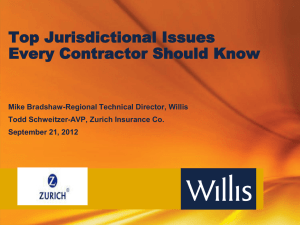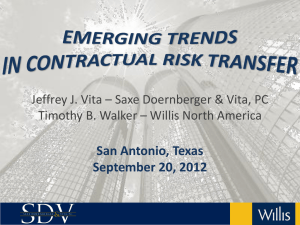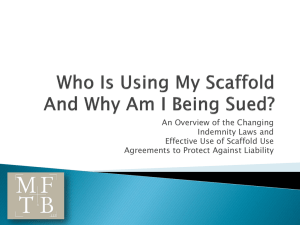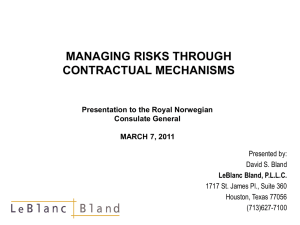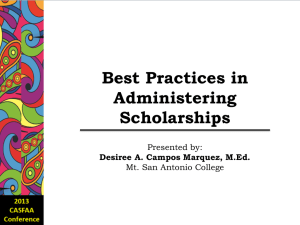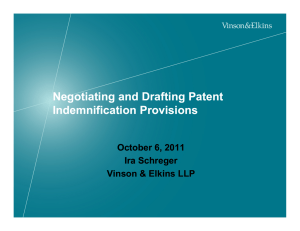Indemnification: Hold Harmless in Defense
advertisement
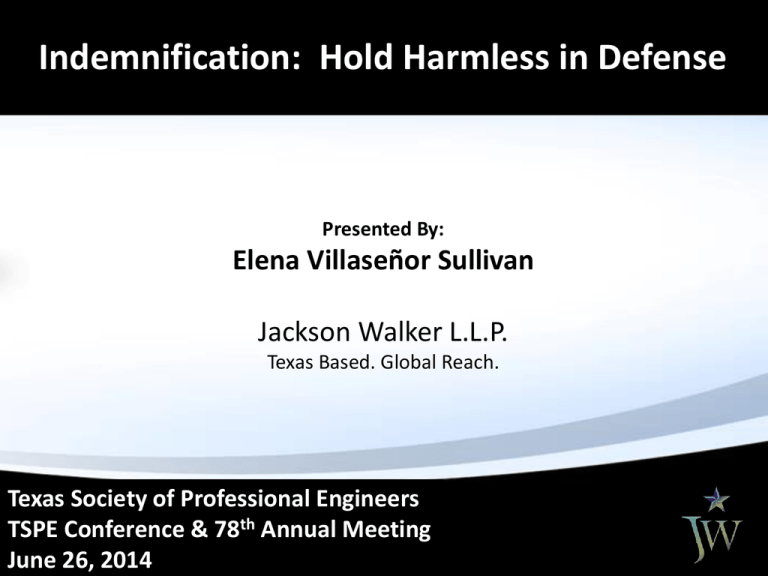
Indemnification: Hold Harmless in Defense dem Presented By: Elena Villaseñor Sullivan Jackson Walker L.L.P. Texas Based. Global Reach. Texas Society of Professional Engineers TSPE Conference & 78th Annual Meeting June 26, 2014 What Are We Going to Talk About Today? 1. What is an Indemnification Agreement? 2. How Do Courts Interpret Indemnity Agreements? 3. When Does an Indemnity Claim Accrue? 4. When Can an Indemnitee Require Indemnity for the Indemnitee’s Own Negligence? 5. What Statutes Prohibit Indemnitors from Assuming the Liability for the Indemnitee’s Own Negligence? What Are We Going to Talk About Today? 1. What is an Indemnification Agreement? 2. How Do Courts Interpret Indemnity Agreements? 3. When Does an Indemnity Claim Accrue? 4. When Can an Indemnitee Require Indemnity for the Indemnitee’s Own Negligence? 5. What Statutes Prohibit Indemnitors from Assuming the Liability for the Indemnitee’s Own Negligence? What is an Indemnification Agreement? The Indemnitee—typically an upper tier party— protects itself from the risk of liability by entering into an agreement with an Indemnitor—a lower tier party—who agrees to assume the Indemnitor’s potential liability. The Indemnitor agrees to safeguard or hold the Indemnitee harmless against either existing and/or future loss, liability, or both. To Summarize… Indemnitor = A person who agrees to assume the liability of another Indemnitee = A person who transfers its liability to another The Duty to Defend is Different The duty to indemnify is not dependent on the duty to defend. There may be a duty to indemnify even if the duty to defend never arises. Generally, The Duty to Indemnify Must Be in a Written Contract One Exception = Vicarious Liability Example = Employer Held Liable for Employee’s Acts or Landlord Held Liable for Tenant’s Acts Typically, It Involves Third Party Liability Generally, an indemnity agreement obligates the indemnitor to protect the indemnitee against claims brought by a person not a party to the agreement. There Are Three Common Types of Indemnity Agreements Broad Form: Transfers all liability and loss to the indemnitor, regardless of fault. Intermediate Form: Transfers all of the indemnitee’s liabilities and losses to the indemnitor so long as the indemnitor has some fault. Limited / Comparative Form: Transfers the indemnitee’s liabilities and losses to the indemnitor only to the extent of the indemnitor’s percentage of fault in contributing to any loss. What Are We Going to Talk About Today? 1. What is an Indemnification Agreement? 2. How Do Courts Interpret Indemnity Agreements? 3. When Does an Indemnity Claim Accrue? 4. When Can an Indemnitee Require Indemnity for the Indemnitee’s Own Negligence? 5. What Statutes Prohibit Indemnitors from Assuming the Liability for the Indemnitee’s Own Negligence? How Do Courts Interpret Indemnity Agreements? No Particular Language is Required It is not necessary to include the words "indemnify" or "indemnity," or any other particular technical terms. Courts Give a Common Sense Reading of the Contract Judges, not juries, decide whether an indemnity agreement is enforceable and the scope of the indemnification Judge’s give effect to the parties’ intent But Courts Strictly Construed in Favor of the Indemnitor If you do not want to the indemnification clause construed in favor of the indemnitor, then states so in the contract. For example, use the following language: This provision should be construed fairly and reasonably and neither more strongly for nor against either party. What Are We Going to Talk About Today? 1. What is an Indemnification Agreement? 2. How Do Courts Interpret Indemnity Agreements? 3. When Does an Indemnity Claim Accrue? 4. When Can an Indemnitee Require Indemnity for the Indemnitee’s Own Negligence? 5. What Statutes Prohibit Indemnitors from Assuming the Liability for the Indemnitee’s Own Negligence? When Does an Indemnity Claim Accrue? An Indemnitor’s Obligations Arise When Liability is Established • In a suit for indemnity, the injury upon which suit might be based does not arise until some liability is established. • The general rule is that a claim for indemnity accrues only when payment is made or judgment is rendered. What Are We Going to Talk About Today? 1. What is an Indemnification Agreement? 2. How Do Court’s Interpret Indemnity Agreements? 3. When Does an Indemnity Claim Accrue? 4. When Can an Indemnitee Require Indemnity for the Indemnitee’s Own Negligence? 5. What Statutes Prohibit Indemnitors from Assuming the Liability for the Indemnitee’s Own Negligence? When Are Broad and Intermediate Form Indemnification Agreements Allowed? When Can an Indemnitee Require Indemnification for Its Own Negligence? There Are Three Common Types of Indemnity Agreements Broad Form: Transfers all liability and loss to the indemnitor, regardless of fault. Intermediate Form: Transfers all of the indemnitee’s liabilities and losses to the indemnitor so long as the indemnitor has some fault. Limited / Comparative Form: Transfers the indemnitee’s liabilities and losses to the indemnitor only to the extent of the indemnitor’s percentage of fault in contributing to any loss. Traditionally, Broad and Intermediate Form Indemnity Agreements Were Common Top-tier contractual parties often bargained for lower-tier parties to assume their liabilities and losses even if the top-tier party’s negligence, strict liability, or comparative liability. Today, Broad and Intermediate Form Indemnity Agreements Can Be Used Only Sparingly Parties may still enter into broad or intermediate form agreements so long as a statute does not prohibit it. Generally, statutes prohibit broad and intermediate form indemnity agreements involving: 1. 2. 3. 4. Construction Contracts Engineers Indemnifying Owners Engineers Indemnifying Governmental Agencies Contractors Indemnifying Engineers Broad and Intermediate Form Indemnity Agreements Require Fair Notice Fair Notice requires that the indemnity agreement complies with: 1. The Express Negligence Doctrine 2. Conspicuousness Requirements The Express Negligence Doctrine = Expressly State the Parties’ Intent No Broad “All Sweeping” Language Subcontractor agrees to indemnify Contractor and hold Contractor harmless from any and all claims, actions, causes of action, or demands of any kind or nature. No Inferences or Implications Subcontractor agrees to indemnify Contractor and hold Contractor harmless from any and all claims, actions, causes of action, or demands of any kind or nature arising from the work under the contract. The Express Negligence Doctrine = Expressly State the Parties’ Intent No Deduction by Process of Elimination Subcontractor agrees to indemnify Contractor and hold Contractor harmless from any and all claims, actions, causes of action, or demands of any kind or nature, except for any claim, action, cause of action, or demand for breach of contract or fraud. Contractor agrees to ... indemnify ... owner ... from and against any and all claims ... of every kind and character whatsoever, ... for or in connection with loss of life or personal injury ... directly or indirectly arising out of ... the activities of contractor ... excepting only claims arising out of accidents resulting from the sole negligence of owner. Conspicuous = a Reasonable Person Should Have Seen It 1. Heading must be different than its surrounding text. • in capitals equal to or greater in size than the surrounding text, or • in contrasting type, font, or color 2. The language content must be different than the surrounding text. • in larger type • in contrasting type, font, or color, or • set off by symbols or other marks that call attention to the language Actual Knowledge Trumps Conspicuousness If an indemnitee can prove the indemnitor had actual knowledge, then the indemnity clause does not have to be conspicuous. Does this Indemnity Clause Meet the Express Negligence Test? E. If any part of this document is ruled unenforceable by a Court of competent jurisdiction under the laws of the State of Texas, then the remainder of the document shall remain in full force and effect. F. SUBCONTRACTOR SHALL INDEMNIFY AND HOLD CONTRACTOR HARMLESS AGAINST ANY LOSS OR DAMAGE TO PERSONS OR PROPERTY AS A RESULT OF OPERATIONS GROWING OUT OF THE PERFORMANCE OF THIS CONTRACT, INCLUDING, BUT NOT LIMITED TO, ANY AND ALL CLAIMS, CAUSES OF ACTION, OR DEMANDS RELATING TO ANY NEGLIGENT ACT OR OMISSION OF CONTRACTOR, ITS OFFICERS, AGENTS OR EMPLOYEES. Does this Indemnity Clause Meet the Express Negligence Test? E. If any part of this document is ruled unenforceable by a Court of competent jurisdiction under the laws of the State of Texas, then the remainder of the document shall remain in full force and effect. F. SUBCONTRACTOR SHALL INDEMNIFY AND HOLD CONTRACTOR HARMLESS AGAINST ANY LOSS OR DAMAGE TO PERSONS OR PROPERTY AS A RESULT OF OPERATIONS GROWING OUT OF THE PERFORMANCE OF THIS CONTRACT, INCLUDING, BUT NOT LIMITED TO, ANY AND ALL CLAIMS, CAUSES OF ACTION, OR DEMANDS RELATING TO ANY NEGLIGENT ACT OR OMISSION OF CONTRACTOR, ITS OFFICERS, AGENTS OR EMPLOYEES. [10 Minute Break] What Are We Going to Talk About Today? 1. What is an Indemnification Agreement? 2. How Do Courts Interpret Indemnity Agreements? 3. When Does an Indemnity Claim Accrue? 4. When Can an Indemnitee Require Indemnity for the Indemnitee’s Own Negligence? 5. What Statutes Prohibit Indemnitors from Assuming the Liability for the Indemnitee’s Own Negligence? What Statutes Eliminate Broad and Intermediate Form Indemnity Agreements? What Statutes Prohibit Indemnitors from Assuming the Liability for the Indemnitee’s Own Negligence? Three Statutes Limit Indemnification in Construction Contracts 1. The Texas Civil Practice & Remedies Code, 2. The Texas Local Government Code, and 3. The Texas Insurance Code If you fall under one of the three statutes, the indemnitee cannot require the indemnitor to assume liability for the indemnitee’s own negligence. Texas Civil Practice & Remedies Code Limits Indemnification Provisions that Apply to Engineers Only Applies to Indemnity Agreements Made In Connection With or Collateral To A Construction Contract "Construction contract" means: 1. a contract or agreement 2. made and entered into by…[a] licensed engineer… 3. concerning the design, construction, alteration, repair, or maintenance of 4. a building, structure, appurtenance, road, highway, bridge, dam, levee, or other improvement 5. to or on real property, 6. including moving, demolition, and excavation connected with the real property. The CPRC governs risk transferring agreements between OWNERS and ENGINEERS An owner cannot seek indemnity from an engineer for liability or damage that is caused by or results from the negligence of an owner Does not apply to construction contracts for a single family or multifamily residence. Does this Indemnity Agreement Conform with the CPRC? Engineer, whose professional services are the subject of this Agreement, covenants and agrees to FULLY INDEMNIFY and HOLD HARMLESS, Owner, employees, officers, directors, volunteers and representatives of the Owner, from and against damages, liabilities or costs, including reasonable attorney fee and defense costs, to the extent caused by Engineer’s negligent performance of professional services under this Agreement and anyone for whom Engineer is legally or contractually is liable. The indemnity provided for in this Section shall not apply to any liability resulting from the negligence of the Owner, its officers or employees. The CPRC also governs risk transferring between ENGINEERS and CONTRACTORS An engineer cannot seek indemnity from a contractor for liability or damage that… An engineer cannot seek indemnity from a contractor for liability or damage that… (1) results from: a) defects in plans, designs, or specifications prepared, approved, or used by engineer; or b) negligence of the engineer in the rendition or conduct of professional duties called for or arising out of the construction contract and the plans, designs, or specifications that are a part of the construction contract; AND (2) arises from: a) b) c) personal injury or death; property injury; or any other expense that arises from personal injury, death, or property injury. Does this Indemnity Agreement Conform with the CPRC? Contractor covenants and agrees to FULLY INDEMNIFY and HOLD HARMLESS, Engineer, and Engineer’s employees, officers, directors, and representatives, from and against damages, liabilities or costs, including reasonable attorney fee and defense costs, from any and all claims, actions, causes of action, or demands of any kind or nature for loss, damage, or liability arising from Contractor’s Work under this Agreement. The indemnity provided for in this Section shall not apply to any liability resulting from defects in plans, designs, or specifications prepared, approved, or used by engineer or negligence of the engineer in the rendition or conduct of professional duties called for or arising out of the construction contract and the plans, designs, or specifications that are a part of the construction contract and arising from personal injury or death, property damage, or any expenses arising therefrom. EXAMPLE Foster, Henry, Henry,& Thorpe, Inc. v. J.T. Const. Co., Inc., 808 S.W.2d 139, 141 (Tex. App.—El Paso 1991, writ denied). Texas Local Government Code Limits Indemnification Provisions that Apply to Engineers The Local Gov’t Code Governs Indemnity Agreements between GOVERNMENTS and ENGINGEERS A governmental agency may generally only require an engineer to indemnify, defend, and hold harmless the governmental agency for the engineer’s…. • negligence, • intentional tort, • • intellectual property infringement, and failure to pay a subcontractor or supplier. “Governmental agency” means a municipality, county, school district, conservation and reclamation district, hospital organization, or other political subdivision of this state. Example of Indemnification Agreements with Governmental Agencies Consultant, whose professional services are the subject of this Agreement, covenants and agrees to FULLY INDEMNIFY and HOLD HARMLESS, City and the elected officials, employees, officers, directors, volunteers and representatives of City, individually and collectively, from and against damages, liabilities or costs, including reasonable attorney fee and defense costs, to the extent caused by Consultant’s negligent performance of professional services under this Agreement and anyone for whom Consultant legally or contractually is liable. The indemnity provided for in this Section shall not apply to any liability resulting from the negligence of City, its officers or employees, in instances where such negligence causes personal injury, death or property damage. IN THE EVENT CONSULTANT AND CITY ARE FOUND JOINTLY LIABLE BY A COURT OF COMPETENT JURISDICTION, LIABILITY SHALL BE APPORTIONED COMPARATIVELY IN ACCORDANCE WITH THE LAWS FOR THE STATE OF TEXAS, WITHOUT, HOWEVER, WAIVING ANY GOVERNMENTAL IMMUNITY AVAILABLE TO THE CITY UNDER TEXAS LAW AND WITHOUT WAIVING ANY DEFENSES OF THE PARTIES UNDER TEXAS LAW. Texas Insurance Code Limits Indemnification Provisions in Construction Contracts The Insurance Code Contains the Broadest Anti-Indemnity Laws in Texas Prohibits any indemnitor from indemnifying, holding harmless, or defending any party, including a third party, against a claim caused by the indemnitee’s…. • negligence or fault, • breach or violation of a statute, ordinance, governmental regulation, standard, or rule, or • breach of contract. How Do You Know If The Insurance Code AntiIndemnity Provisions Apply To Your Contract? Must answer YES to all of the following questions: 1. Is your contract a construction contract or incidental to a construction contract? 2. Does the contract involve a construction project? 3. Is there or will there be a Consolidated Insurance Program for the project? How Do You Know If The Insurance Code AntiIndemnity Provisions Apply To Your Contract? Must answer YES to all of the following questions: 1. Is your contract a construction contract or incidental to a construction contract? 2. Does the contract involve a construction project? 3. Is there or will there be a Consolidated Insurance Program for the project? Does your contract involve a construction contract? "Construction contract" means: 1. a contract, subcontract, or agreement, or a performance bond, 2. entered into or made by an owner, architect, engineer, contractor, construction manager, subcontractor, supplier, or material or equipment lessor 3. for the design, construction, alteration, renovation, remodeling, repair, or maintenance of, or for the furnishing of material or equipment for, 4. a building, structure, appurtenance, or other improvement to or on public or private real property, including moving, demolition, and excavation connected with the real property. “Construction Contract” includes: • an assignment of the construction contract or other modifications thereto. • any related subcontracts, purchase orders, personal property lease agreements, and insurance policies. How Do You Know If The Insurance Code AntiIndemnity Provisions Apply To Your Contract? Must answer YES to all of the following questions: 1. Is your contract a construction contract or incidental to a construction contract? 2. Does the contract involve a construction project? 3. Is there or will there be a Consolidated Insurance Program for the project? If yes, does your contract involve a construction project? “Construction project” means construction, remodeling, maintenance, or repair of improvements to real property. • Includes: the immediate construction location and areas incidental and necessary to the work as defined in the construction contract documents. • Does not include: a single family house, townhouse, duplex, or land development directly related thereto. How Do You Know If The Insurance Code AntiIndemnity Provisions Apply To Your Contract? Must answer YES to all of the following questions: 1. Is your contract a construction contract or incidental to a construction contract? 2. Does the contract involve a construction project? 3. Is there or will there be a Consolidated Insurance Program for the project? If yes, is there a consolidated insurance program for the project? The indemnitor is provided or procures general liability insurance, worker’s compensation insurance, casualty insurance or property insurance. But, There Are Many Exceptions to the Insurance Code Anti-Indemnity Agreement • Claims for bodily injury or death of an employee of the indemnitor, its agent, or its subcontractor of any tier; • Breach of contract or warranty actions; • Loan and financing actions; • General surety agreements; • Worker’s compensation benefits; • Licenses or access agreements with railroad companies. Example of Indemnity Agreement Under the Insurance Code Consultant, whose professional services are the subject of this Agreement, covenants and agrees to FULLY INDEMNIFY and HOLD HARMLESS, City and the elected officials, employees, officers, directors, and representatives of City, individually and collectively, from and against damages, liabilities or costs, including reasonable attorney fee and defense costs, to the extent caused by Consultant’s negligent performance of professional services under this Agreement and anyone for whom Consultant legally or contractually is liable, breach of contract, and/or violation of any statute, regulation, or ordinance, or government standard or rule by the City or its employees. The indemnity provided for in this Section shall not apply to any liability resulting from the negligence or fault of City, its officers or employees, a breach of contract by the City, its officers or employees, and the violation of any statute, regulation, ordinance, or government standard or rule by the City or its employees. Elena Villaseñor Sullivan Jackson Walker L.L.P. 112 East Pecan Street, Suite 2400 San Antonio, Texas 78205 (210) 978-7758 esullivan@jw.com
